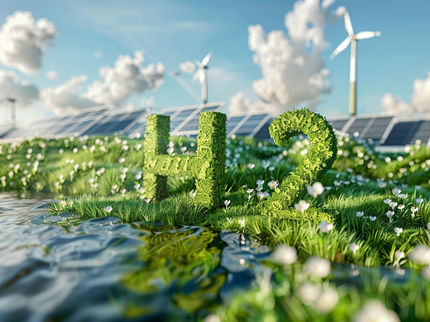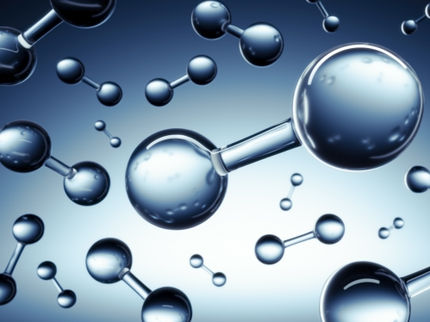Light green hydrogen will do
“It would be counterproductive to aim for complete decarbonisation, as the excessive costs could slow down the energy transition”
Whether sustainably produced hydrogen needs to be 100 percent green is currently under debate. Using the production of ammonia and artificial fertiliser as examples, researchers have calculated that "nearly sustainable" hydrogen would be better in the end.
There’s a role for sustainably produced hydrogen in the energy transition, and not only as an energy storage medium or as fuel for lorries. In industry, it could be used wherever hydrogen is already needed today: for example, in the production of ammonia. Worldwide, 180 million tonnes of ammonia are produced every year, mainly for the fertiliser industry. The necessary hydrogen is currently obtained from natural gas, which results in high greenhouse gas emissions and a reliance on gas-exporting countries. Using green hydrogen as a clean alternative would bring the world closer to climate targets and reduce dependency. Green hydrogen is produced using sustainable electricity via a process called electrolysis.
In a study looking at the European ammonia industry, researchers from the Hong Kong University of Science and Technology (HKUST) and ETH Zurich have now calculated the conditions under which it would be worthwhile to switch ammonia production to green or almost green hydrogen.
Already economically viable in Spain and Norway
Two results stand out. First, in some European countries such as Norway, Spain, Hungary or Poland, ammonia production from green or almost green hydrogen would already make economic sense today. In these countries, generating sustainable electricity from solar or wind energy is particularly cost-effective. This is thanks to these countries’ favourable geographical conditions, as well as state subsidies or generally low electricity costs. The latter means that, in the absence of sunshine or wind, hydrogen production could fall back on cheap power from the grid. As a result, producers here could do without expensive storage solutions for sustainable electricity.
Second, even electricity that isn’t completely fossil-free will still have a thoroughly positive climate impact. According to the study, hydrogen from electrolysis makes sense even if some of the power used isn’t from renewable sources. This gives producers the freedom to switch to electricity from the grid, some of which comes from fossil sources, whenever the sun or wind is in short supply.
One kilogramme of CO2 would be fine for the climate
The study’s lead author is Stefano Mingolla, a doctoral student at HKUST. He worked for six months in the group led by Giovanni Sansavini, Professor at the Department of Mechanical and Process Engineering at ETH Zurich. “If you use almost green hydrogen to produce ammonia, you can achieve a lot very quickly – it’s low-hanging fruit,” Sansavini says. “This is in contrast to other applications, where hydrogen serves merely as energy storage and requires conversion from one form of energy to another. In ammonia production, hydrogen is used directly as a raw material, eliminating the need for inefficient conversions.”
Calculations by Mingolla and his colleagues show that greenhouse gas emissions from ammonia production could be reduced by 95 percent compared to today if the hydrogen used were produced in a way that releases no more than one kilogramme of CO2 per kilogramme of hydrogen. The electricity required for this would have to be significantly greener than the current mix in Germany, Poland and the Netherlands. These three countries are the largest ammonia producers in Europe. For comparison: one kilogramme of hydrogen produced using the Swiss electricity mix would lead to emissions of 1.7 kilogrammes of CO2; the figure using the current electricity mix in Germany would be 18 kilogrammes of CO2, in the Netherlands 16 kilogrammes and in Poland 33 kilogrammes.
Decarbonising hydrogen production completely, rather than just by 95 percent, would be prohibitively expensive. The last 5 percent of decarbonisation is the most complex and costly; it would almost double the overall price tag. “It’s important to adjust ambitions accordingly,” Sansavini says. “It would be counterproductive to aim for complete decarbonisation, as the excessive costs could slow down the energy transition.”
New solar and wind parks for hydrogen production
However, Sansavini emphasises that hydrogen won’t be produced on a large scale using electricity from the grid since, in many cases, both local power generation and cross-border grid transmission capacity are inadequate.
A more likely scenario is for new solar or wind farms to be built directly next to existing ammonia plants. However, this requires large areas of land. As the study shows, the more a given region enjoys favourable geographical conditions for generating electricity from solar or wind energy, the less land is needed. Southern Europe and areas along the Atlantic coast have an advantage here. “Because the amount of land required is so large, we need to think primarily about combined land use – for instance, a wind or solar farm where agriculture can be practised at the same time,” Sansavini says.
Green hydrogen might already be competitive in Norway, Spain, Hungary and Poland, but on average across Europe, producing it is significantly more expensive than extracting hydrogen from natural gas. “For green hydrogen to become competitive everywhere, further investment in research and development is needed, as are economic incentives,” Sansavini says. What exactly is meant by “green” hydrogen is also currently being discussed in the EU. “We need to balance the costs and the environmental impact. Any definition should permit green hydrogen to contain some residual fossil energy,” Sansavini explains. Using the example of ammonia production, the research team has now calculated a recommendation for this residual proportion: up to one kilogramme of CO2 emissions per kilogramme of hydrogen would be acceptable and sensible.
Original publication
Stefano Mingolla, Paolo Gabrielli, Alessandro Manzotti, Matthew J. Robson, Kevin Rouwenhorst, Francesco Ciucci, Giovanni Sansavini, Magdalena M. Klemun, Zhongming Lu; "Effects of emissions caps on the costs and feasibility of low-carbon hydrogen in the European ammonia industry"; Nature Communications, Volume 15, 2024-5-4


































































